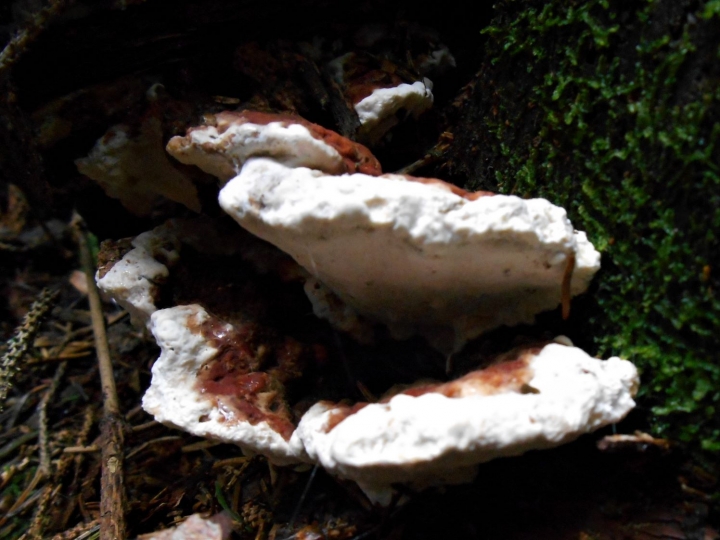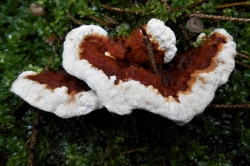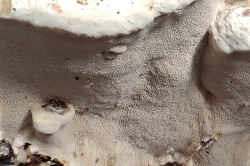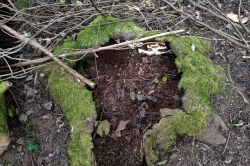A beautiful perennial polypore with bright red skin and white to cream pore surface. It might be a real nightmare, if you have a conifer plantation.
Home / Mushroom Guide /
Root Rot
Root Rot
| Mushroom Type | |
| Common Names |
Root Rot (EN), Golosged y Gwraidd (CY), Korzeniowiec Wieloletni (PL), Gyökérrontó Tapló (HU) |
| Scientific Name |
Heterobasidion annosum |
| Season Start |
All |
| Season End |
All |
| Average Mushroom height (CM) | |
| Average Cap width (CM) |
5–30 |
Please note that each and every mushroom you come across may vary in appearance to these photos.
Fruiting Body
Perennial, 5–30 across. Its shape is irregular, effused-reflexed, or resupinate. If not resupinate, it is projecting up to 10 cm from the substrate. Broadly attached to the substrate without having a stem (sessile).
Sterile (upper) surface is reddish brown to almost blackish, zoned. Rough, tough, tuberculate, covered with fine short hairs (pubescent). Margin is rounded, white when still in constant growing, concolorous with the sterile surface with age.
Pores
Tubes 2–5 mm long, whitish, darker with age. Pores 4–5 per mm, round to angular, white to cream.
Flesh
0.3–1 cm thick, tough, corky-woody, homogenous, and white to off white.
Habitat
Grows on living and dead conifers, particularly Pines (Pinus spp.), but rarely can be found on other conifers, and even on hardwoods (e.g., Beech) too. It is a well-known plant pathogen species, a necrotrophic parasite, which causing white-rot and butt-rot.
Possible Confusion
Hence it is a member of a species complex (with 4 species in Europe and likely 5 species in the US), it can be confused with other members of the complex.
H. irregulare also grows on Pines (Pinus spp.) and it can be just as big as H. annosum, but it has smaller pores (7 per mm) than H. annosum (which normally has 4–5 per mm).
H. abietinum grows on Firs (Abies spp.), and it has much wider pores (2–3 per mm) than H. annosum (4–5 per mm).
H. parviporum grows on Spruces (Picea spp.), and it has a bit smaller pores (4–7 per mm) than H. annosum (4–5 per mm).
We are not aware of the existence of these species from other areas in Europe other than the Mediterranean region, but it doesn’t mean they are absent from the British Isles.
Taste / Smell
Inedible. It has a rather strong, sweet, floral smell (when fresh), however, A. Bernicchia and S.P. Gorjón (2020) wrote, it has “pungent smell”; taste unknown.
Frequency
Common and widespread.
Spores
Spore print is white. Spores almost spherical (subglobose), colourless (hyaline), finely spiny (echinulate), and inamyloid (meaning: there is no starch in the spore wall).
Other Facts
Would you believe me if I would say this species is a distant relative of brittlegills? No? No problem. It doesn’t change the fact that Root Rot (Heterobasidion annosum) belongs to the Bondarzewiaceae family, which is on Russulales order.
The genus name Heterobasidion is made from two words: ‘héteros’ [Greek: ἕτερος] means other, different, other than usual, etc; while ‘basidion’ [constructed from the Greek ‘basis’ or βάσις which means base, and the suffix ‘-ídion’ or -ίδιον] refers to the basidia. The epithet (2nd part of the scientific name), ‘annosum’, has Latin origin and it means, ‘aged’ or ‘many years old’.
Heterobasidion annosum is the type species of genus Heterobasidion.



 (2 votes, average: 3.50 out of 5)
(2 votes, average: 3.50 out of 5)























Leave a Reply